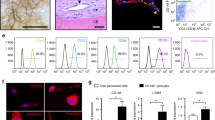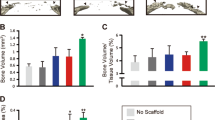Abstract
Human pericytes are a perivascular cell population with mesenchymal stem cell properties, present in all vascularized tissues. Human pericytes have a distinct immunoprofile, which may be leveraged for purposes of cell purification. Adipose tissue is the most commonly used cell source for human pericyte derivation. Pericytes can be isolated by FACS (fluorescence-activated cell sorting), most commonly procured from liposuction aspirates. Pericytes have clonal multilineage differentiation potential, and their potential utility for bone regeneration has been described across multiple animal models. The following review will discuss in vivo methods for assessing the bone-forming potential of purified pericytes. Potential models include (1) mouse intramuscular implantation, (2) mouse calvarial defect implantation, and (3) rat spinal fusion models. In addition, the presented surgical protocols may be used for the in vivo analysis of other osteoprogenitor cell types.
Access this chapter
Tax calculation will be finalised at checkout
Purchases are for personal use only
Similar content being viewed by others
References
Collett GD, Canfield AE (2005) Angiogenesis and pericytes in the initiation of ectopic calcification. Circ Res 96(9):930–938
Doherty MJ, Canfield AE (1999) Gene expression during vascular pericyte differentiation. Crit Rev Eukaryot Gene Expr 9(1):1–17
Farrington-Rock C et al (2004) Chondrogenic and adipogenic potential of microvascular pericytes. Circulation 110(15):2226–2232
Invernici G et al (2007) Human fetal aorta contains vascular progenitor cells capable of inducing vasculogenesis, angiogenesis, and myogenesis in vitro and in a murine model of peripheral ischemia. Am J Pathol 170(6):1879–1892
Howson KM et al (2005) The postnatal rat aorta contains pericyte progenitor cells that form spheroidal colonies in suspension culture. Am J Physiol Cell Physiol 289(6):C1396–C1407
Covas DT et al (2005) Mesenchymal stem cells can be obtained from the human saphena vein. Exp Cell Res 309(2):340–344
Crisan M et al (2008) A perivascular origin for mesenchymal stem cells in multiple human organs. Cell Stem Cell 3(3):301–313
Murray IR et al (2014) Natural history of mesenchymal stem cells, from vessel walls to culture vessels. Cell Mol Life Sci 71(8):1353–1374
Meyers CA et al (2018) Pericytes for therapeutic bone repair. Adv Exp Med Biol 1109:21–32
James AW et al (2017) Pericytes for the treatment of orthopedic conditions. Pharmacol Ther 171:93–103
James AW, Peault B (2019) Perivascular mesenchymal progenitors for bone regeneration. J Orthop Res 37(6):1221–1228
Zhang X et al (2011) The Nell-1 growth factor stimulates bone formation by purified human perivascular cells. Tissue Eng Part A 17(19-20):2497–2509
James AW et al (2012) Perivascular stem cells: a prospectively purified mesenchymal stem cell population for bone tissue engineering. Stem Cells Transl Med 1(6):510–519
Askarinam A et al (2013) Human perivascular stem cells show enhanced osteogenesis and vasculogenesis with Nel-like molecule I protein. Tissue Eng Part A 19(11-12):1386–1397
Wang Y et al (2020) PDGFRalpha marks distinct perivascular populations with different osteogenic potential within adipose tissue. Stem Cells 38(2):276–290
Chung CG et al (2014) Human perivascular stem cell-based bone graft substitute induces rat spinal fusion. Stem Cells Transl Med 3(10):1231–1241
Lee S et al (2015) Brief report: human perivascular stem cells and Nel-like Protein-1 synergistically enhance spinal fusion in osteoporotic rats. Stem Cells 33(10):3158–3163
Tawonsawatruk T et al (2016) Adipose derived pericytes rescue fractures from a failure of healing—non-union. Sci Rep 6:22779
Wang Y et al (2019) Relative contributions of adipose-resident CD146(+) pericytes and CD34(+) adventitial progenitor cells in bone tissue engineering. NPJ Regen Med 4:1
Corselli M et al (2012) The tunica adventitia of human arteries and veins as a source of mesenchymal stem cells. Stem Cells Dev 21(8):1299–1308
Corselli M et al (2013) Identification of perivascular mesenchymal stromal/stem cells by flow cytometry. Cytometry A 83(8):714–720
James AW et al (2012) An abundant perivascular source of stem cells for bone tissue engineering. Stem Cells Transl Med 1(9):673–684
West CC et al (2016) Prospective purification of perivascular presumptive mesenchymal stem cells from human adipose tissue: process optimization and cell population metrics across a large cohort of diverse demographics. Stem Cell Res Ther 7:47
Xu J et al (2020) Comparison of skeletal and soft tissue pericytes identifies CXCR4+ bone forming mural cells in human tissues. Bone Res 8:22
James AW et al (2012) Use of human perivascular stem cells for bone regeneration. J Vis Exp 63:e2952
Lo DD et al (2012) Repair of a critical-sized calvarial defect model using adipose-derived stromal cells harvested from lipoaspirate. J Vis Exp 68:4221
James AW et al (2012) Perivascular stem cells: a prospectively purified mesenchymal stem cell population for bone tissue engineering. Stem Cells Transl Med 1(6):510–519
Spicer PP et al (2012) Evaluation of bone regeneration using the rat critical size calvarial defect. Nat Protoc 7(10):1918–1929
Lee S et al (2015) hPSCs and NELL-1 synergistically enhance spinal fusion in osteoporotic rats. Stem Cells 33(10):3158–3163
Zhang X et al (2011) The Nell-1 growth factor stimulates bone formation by purified human perivascular cells. Tissue Eng Part A 17(19-20):2497–2509
Levi B et al (2011) Dura mater stimulates human adipose-derived stromal cells to undergo bone formation in mouse calvarial defects. Stem Cells 29(8):1241–1255
Acknowledgments
A.W.J. was supported by the NIH/NIAMS (R01 AR070773, K08 AR068316), NIH/NIDCR (R21 DE027922), Department of Defense (W81XWH-18-1-0121, W81XWH-18-1-0336, W81XWH-18-10613), American Cancer Society (Research Scholar Grant, RSG-18-027-01-CSM), the Maryland Stem Cell Research Foundation, MTF Biologics, and Novadip. The content is solely the responsibility of the authors and does not necessarily represent the official views of the National Institutes of Health, Department of Defense, or U.S. Army.
Disclosures: K.T, B.P, and C.S. are inventors of PSC-related patents filed from UCLA. A.W.J. is a paid consultant for Novadip. This arrangement has been reviewed and approved by the Johns Hopkins University in accordance with its conflict of interest policies.
Author information
Authors and Affiliations
Corresponding author
Editor information
Editors and Affiliations
Rights and permissions
Copyright information
© 2021 Springer Science+Business Media, LLC, part of Springer Nature
About this protocol
Cite this protocol
Meyers, C.A. et al. (2021). Assessing the Bone-Forming Potential of Pericytes. In: Péault, B.M. (eds) Pericytes. Methods in Molecular Biology, vol 2235. Humana, New York, NY. https://doi.org/10.1007/978-1-0716-1056-5_9
Download citation
DOI: https://doi.org/10.1007/978-1-0716-1056-5_9
Published:
Publisher Name: Humana, New York, NY
Print ISBN: 978-1-0716-1055-8
Online ISBN: 978-1-0716-1056-5
eBook Packages: Springer Protocols




